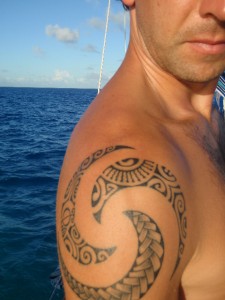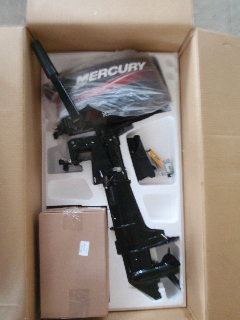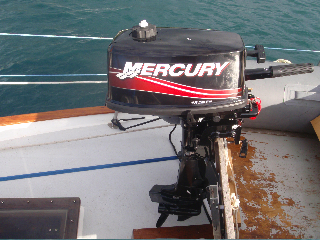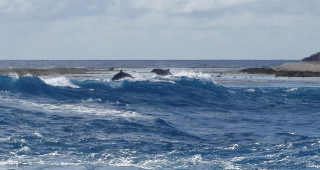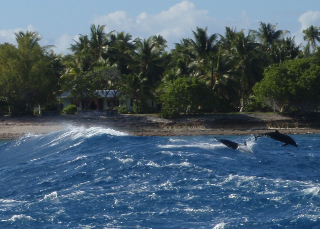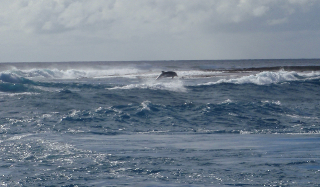Aug 29 2010
Scuba Diving at Beveridge Reef
(refers to events that happened August 22nd and 23rd)
I finally did some real scuba diving with my own gear. Or rather the gear I’ve borrowed from the Martins. Thanks Pat and Dave!
In Rangiroa, I purchased a dive outing with a local dive operator, 6 Passengers, so named because they limit the number of people with one dive guide to, yes, six people. Scuba diving through Passe Tiputa was extremely fun. I had almost as much fun simply remembering how to scuba dive as I did watching sharks or fish or coral. I wanted my first time to be with a dive outfit, just so I could remind myself what it was like. I was certified 15 years ago, and then took a three hour refresher course. So in the last 14 years, I have only been scuba diving once, four months ago, in a pool. My point being I wanted the first time I went to be with a dive master.
Then in Moorea, I decided to test out the dive equipment we have. I only got through two regulators (of five), one BCD (of three) and both tanks before wanting to actually have fun. And so with the dive gear on, I hopped into 12 feet of water where we were anchored and scrubbed the bottom of our boat. I burned through over half of one tank doing that, but it was enjoyable nonetheless.
But finally, in Beveridge Reef, I went scuba diving with my own gear. Matt and Karen were snorkeling above me as we explored the pass into Beveridge Reef. One day we were at the south side of the entrance and the other the north.
Both were spectacular! On the south side, I went down to the floor at about 40 feet. There was a fairly hefty current at the surface, but on the bottom it was not nearly as bad, and I could just kneel in the dirt to keep myself from moving. The fish, though, the fish!! Three foot long bumphead parrot fish were there, at least a hundred it seemed. Large groupers also abounded. Both would swim up almost next to you! I could have easily touched them if they would have stayed put. But they darted quickly away.
The main attraction for me was the slots in the reef. Underwater canyons! One in particular was about 12 wide with 20 foot high walls of coral. Swimming along the sandy bottom in this canyon was spectacular. Fish were everywhere. Like canyoneering on land, there was obstacles to maneuver around, boulders in the middle of the canyon and such. And within the canyon, within this canyon were sharks.
The sharks, up to six feet in length lazily meandered around. Most were smaller. Some were hefty with girth. Frequently the sharks would swim to within ten feet of me, as I knelt on the surface wondering what it thought of me. Then it would angle slowly away, apparently I was rejected as something to eat.
The north side of the Beveridge Reef pass held even more fish. There were hardly any parrotfish, but was a school of smaller silvery fish. There must have numbered in the thousands. In one particular instance, they completely surrounded me and were swimming in a 360 degree circle around me. They were everywhere I turned, spinning around me in their attempts to protect themselves and keep me, as the potential predator, in confusion. I felt like I was in one of the Blue Planet movies, when they show the schools of fish swimming in giant spheres.
The north side had an enormous overhang of coral, undercut by nearly 20 feet. With a sandy bottom, I just kneeled down and watched the multitudes of ocean life cruise by. This time, not just a few sharks but dozens. It was fantastic to see. I also drifted over to another coral garden 100 yards away that had grabbed my attention. The attraction here was a ten foot high arch made of coral that I wanted to swim through.
Thanks again to Pat and Dave Martin for the scuba gear they loaned us. Also a thanks to Dave, from the trawler Rock and Roll her at the Emeryville Marina who also gave us some scuba gear. Diving in Tonga awaits and in Fiji, in Fiji its supposed to be spell-binding. Fantastic!
(video of scuba diving and snorkeling at Beveridge Reef will be coming later when we get a faster internet connection)
